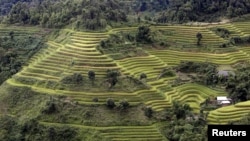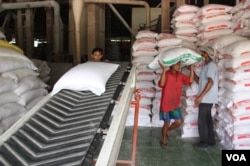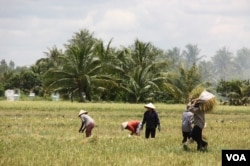Vietnam’s government is banking on agricultural reforms in its main rice producing region to meet the challenges posed by climate change and disrupted water flow on the Mekong River.
The reforms aim to produce higher quality climate-adapted rice, and boost alternative crops to ensure sustainability in the Mekong Delta, home to 18 million of Vietnam’s 94 million people.
The region, which produces more than half of Vietnam’s rice and feeds over 145 million people in Asia, covers 13 provinces in Vietnam’s south where the river flows into the South China Sea.
The Mekong, with its source in the Tibetan plateau, runs 4,300 kilometers through six countries from China, Myanmar, Laos, Thailand and Cambodia before reaching Vietnam.
Climate change
Heightened concerns over the Delta’s future followed an extreme drought this year that resulted in sharply higher salinity levels intruding into the delta. Rice production fell 1.1 million tons according to the United Nation’s Food and Agriculture Organization (FAO).
Sydney University professor Philip Hirsch says climate change’s impact is evident due to more extreme weather.
“Climate change, sea level rise in particular, but also increasing frequency of storms has implications for the Delta. One of the big concerns is the amount of salt water and the distance the salt water moves up various Mekong tributaries into the delta, which again threatens the viability of rice farming,” said Hirsch, a member of the university’s school of geo-sciences.
CLUES
International scientists are working with their Vietnam colleagues through CLUES – or climate change affecting land use in the Mekong Delta – to find solutions to the rising problems.
A CLUES project coordinator Dr N.D. Phong, in a promotional video, said key issues the Delta faces include rising salt and fresh water levels, higher temperatures, rising greenhouse gases and a higher population.
The region also faces the prospect of lower rainfall, reduced numbers of farm laborers and reduced valuable land.
CLUES scientists are developing rice varieties able to cope with rising salinity when water levels are too high or dry conditions, aimed at sustainable solutions for all delta rice production regions.
ACIAR
Australia’s Center for International Agricultural Research (ACIAR) is assisting Vietnam to improve rice production inefficiencies.
ACIAR scientists say Vietnamese rice farmers have successfully adapted to changes over the past 30 years. But the outlook is still concerning.
“Recent and [future] forecasts of agro-hydrological changes threaten the viability of these farming and social systems and food security within South East Asia,” an ACIAR research report said.
Leocadio Sebastian, Vietnam-based regional program leader South East Asia for the International Rice Research Institute (IRRI) says Vietnam’s strategy is to raise farm incomes and boost rice quality by creating a distinctive Vietnamese rice brand.
Sebastian says IRRI and the Vietnamese government aim to restructure the rice sector from three rice crops a year to two crops, but grow a higher value grain.
“That means you have other crops when faced by rising salinity that are more adapted to these kind of conditions. And then in areas where it’s really not possible anymore to plant rice – where it is very salty – salinity will be very high in the future they can move to either aquaculture or other crops during the period,” Sebastian said.
“That is the strategy – the compelling thing that is driving them up faster – they have to position the Vietnam rice to a higher quality and higher priced level so that the farmers now and in the future can have a better income from rice production,” he told VOA.
Hydropower dams
But scientists say Vietnam’s delta also faces the threat from increasing numbers of hydropower dams being built on Mekong River mainstream, especially China, as well as Laos and Cambodia.
Chris Barlow, an ACIAR fisheries expert, says the mainstream dams will have a profound impact on the lower Mekong regions.
“China has completed three large dams on the Mekong and a further five are being built or being planned. These dams have major impacts on hydrology and completely block fish migration in the Upper Mekong,” Barlow said in a paper highlighting the conflicting agendas between hydro power and fisheries.
Plans for hydro-power in lower Mekong – nine high level dams in Laos, with two underway – the Xayaburi and Don Sahong – and two in Cambodia point to “severe impacts” on fisheries yield and food security, he said.
Scientists say the dams will prevent vital sediment from reaching the Delta, alter flow regimes, lower water temperatures of dam outlets and create still water environments upstream of dam walls.
Barlow says while there may be economic gains from hydro-power, “On the debit side, the fishery and other ecosystem services provided by the river will be permanently degraded.”
Sediment
The Mekong Delta relies on silt flowing downstream. But silt levels reaching the region have fallen dramatically due to the construction of dams.
Le Anh Tuan, deputy head of the Institute of Climate Change Research at Can Tho University, told Vietnamese media that damming and reduced silt deposits threatened the Delta’s future.
Sydney University’s Hirsch says Vietnam’s government need to be “more assertive” with members of the intergovernmental Mekong River Commission (MRC) to “try and put a brake on the very rapid pattern of hydrological development in the upstream countries.”
But Hirsch fears the Delta Region’s most productive years may have been before damming on the river began.
In the early 1990’s, Vietnam, through major reforms, moved from being a major global rice importer to being the world’s second largest exporter.
“This is also a time when the entire length of the Mekong River ran freely. Once China started to dam its section of the Mekong and much more recently, Laos… This is the start of the long decline and potential disaster environmental and also food security disaster of the Mekong Delta,” Hirsch said.










